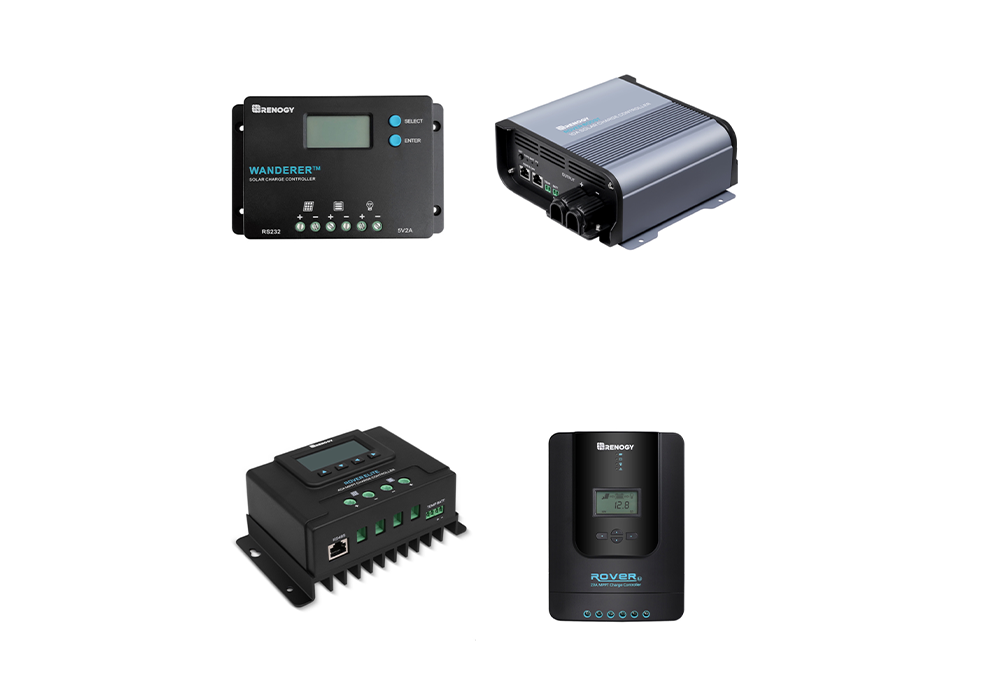The longevity and effectiveness of your solar system are dependent on the charge controller you choose. You will get much closer to offsetting your use of conventional power grid or other energy sources if you optimize the power flowing in from your photovoltaic panels.
You will also be shielding yourself from unexpected and unnecessary replacement charges. Researching and investing in a charge controller for your solar system is worth it. Pick a scalable and adequate choice for your energy needs when getting a charge controller.
Renogy can help you with everything from improving your present system to installing solar panels to selecting the best equipment for your specific needs.
Solar charge controllers protect the batteries from being overcharged and prevent power from retrograding overnight, draining the batteries. PWM and MPPT are the two alternative charge controllers. MPPT and PWM, however, have some differences in their functionality.
What are Solar Charge Controllers
Solar charge controllers are current controllers that prevent solar panels from overcharging batteries. Overcharging any battery can result in permanent damage. In the worst-case situation, overheating and excessive pressure might result in catastrophic repercussions when released.
A load control circuit is usually included in smaller charge regulators. Additional load regulation switches and circuits can be utilized on bigger controllers. A relay motor is typically used with a charge controller to turn relays to control load management. The relay driver has four channels to target more vital loads and keep them on for longer. You may also use it to regulate the start of a solar generator and receive alert signals.
Solar charge controllers with more complex features may also control temperature and modify battery charging to maximize charging. Temperature compensation occurs when a battery charges to a greater voltage in cold conditions and a reduced voltage in hot conditions.
The solar controller performs essential load balance and monitoring duties and ensures long-term battery life under a variety of operating circumstances.
What is a PWM charge controller?
PWM (Pulse Width Modulation) is a charge controller that works by directly linking the solar panel and the battery.
When a constant link is made between a battery and a solar panel while charging, the solar cells output current is reduced to balance with the battery's current. When the solar cell current increases, the battery's current rises too ultimately enabling the battery to take in more voltage as it charges.
What is an MPPT solar charge controller?
A maximum power point tracker (MPPT) is an electrical DC-DC power converter that balances energy output and output in a solar system. Simply put, MPPT converts the greater voltage DC power from solar cells (and a few wind turbines) to the lesser voltage required to charge a battery.
Why are Solar Charge Controllers generating so much interest?
Using a solar system to charge a battery is distinct and demanding. When a solar cell produced too much energy in the past, simple switch controls were utilized to control battery outgassing. However, as photovoltaic systems advanced, it became evident how much these little gadgets hampered the charging process.
PWM and MPPT charge controllers are significant advancements in solar battery charging. When a battery's voltage hits the regulatory set point, the charge controllers mechanism effectively decreases the charging voltage to prevent the battery from overheating and gassing while returning the maximum power to the battery simultaneously.
The result of voltage regulation is greater charging efficacy, faster recharging, a big save on solar panel maintenance, and a robust battery.
Furthermore, PWM and MPPT charge controllers promise some fascinating and distinct benefits. These are some of them:
The ability to restore the battery's power
Sulfation is responsible for 84 percent of all battery issues, as per the Battery Council International. Sulfation is a bigger issue with solar systems because solar charging isn't the same as regular battery charging.
Lengthy bouts of undercharging, typical in solar systems, lead to grid degradation and sulfate crystals to form on the positive terminals of the battery.
Renogy's PWM charge controller can aid in overcoming the resistance shield on the battery surface and break through the corrosion at the interface, preventing the accumulation of sulfate deposits.
There is significant proof that this type of charging can restore capacity lost in a battery bank and enhance charge uptake and performance.
Increasing the battery's charge acceptance
Charge acceptance is a word that is frequently used to define the efficacy with which solar panels can recharge a battery. Since solar batteries continually recharge with a restricted-energy source, a maximum charge acceptance is essential for system efficiency.
A high battery state-of-charge (SOC) is necessary for battery longevity and the preservation of the backup storage capacity vital for solar system dependability. The lifespan of a battery is related to the average state-of-charge, and a battery kept above 90 percent SOC can give 2-3 times higher charge cycles than a battery permitted to approach 50 percent SOC before refilling.
Reducing Battery Heating and Gassing
A decrease in instantaneous gassing characterizes pulse charging. PWM will finish the recharging task quicker and more effectively, resulting in less gassing and heating.
PWM improves the efficiency of ionic movement in the battery. Following a voltage pulse, certain parts of the battery become practically ion-depleted, while others are oversupplied.
Automatically adjusts battery aging
Batteries grow increasingly resistant to charging as they age. This is due to sulfate crystals, which make the battery plates resistive and impede the electrical conversion. PWM continuous voltage charging, on the other hand, is unaffected by age.
The PWM continuous voltage recharging will respond to the battery's demands in real-time.
Balancing battery cells that have drifted
Over time, the charge resistance of different battery cells may become progressively variable. In weaker cells, inconsistent charge uptake can result in substantial capacity loss. Equalization is a technique for rebalancing imbalanced cells.
PWM higher charge uptake and capacity restoration abilities occur at reduced charging voltages. Where equalization charges are not practicable in a solar system, PWM will keep the different batteries in proper balance.
Self-regulating voltage dips and temperature variations
The crucial ending charge tapers with PWM continuous charging, which results in a self-regulating final charge.
As a result, external system elements like voltage dips in system wiring will not cause the critical final charging step to be distorted.
In essence, the PWM charge controller will deliver recharging current based on the battery's requirements and what the controller PWM can give. On the other hand, primary on-off controllers apply external control of the charging process that is often unresponsive to the battery's specific demands.
Differences between PWM and MPPT
A charge controller is an essential element of a solar energy system, and choosing the finest one for the job necessitates some research. Here's a brief rundown.
PWM and MPPT are the two battery charge controllers widely utilized in solar systems. Both modify charging rates to avoid overheating.
If the only element to consider when choosing a solar controller was charging potential, everyone would choose an MPPT controller. However, the selection is based on several factors, including site circumstances, components of the system, solar panel size, temperature, and, lastly, the pricing.
Cost
MPPT charge controllers are much more costly than PWM controllers, and they're more effective under certain situations, allowing them to produce more energy with the same amount of solar panels. You should first examine the site to ensure that the MPPT can work more efficiently under the system's specific set of parameters.
Pricing becomes less essential than the entire cost of the solar system when choosing one controller over another. If you're choosing a controller technology based on price, be sure to consider achieved efficiency, mode of operation, and site circumstances.
Type of Solar Panels
Off-grid photovoltaic panels for stand-alone use are generally 36 cells and interoperable with PWM and MPPT charge controllers. Some solar panels in the industry are not the standard 36-cell modules used in off-grid energy systems. A 60-cell 250W array, for instance, has a voltage that is too powerful for a 12-volt battery and low for a 24-volt battery. MPPT records the peak power level of the less costly modules to charge the batteries, while PWM does not.
Battery System Size
PWM controllers are preferable for low-power applications because:
- A PWM controller maintains reasonably consistent yield efficiency regardless of the panel size.
- A PWM controller is far less costly than an MPPT controller, making it a more cost-effective option for a small system.
- In low-energy applications, an MPPT controller is substantially less efficient.
Temperature Condition
In colder climates, an MPPT controller is more appropriate. The voltage increases when the working temperature of the solar module decreases. This is because solar panels' maximum voltage during standard testing conditions is around 17V, whereas the battery capacity is 13.5V. Surplus panel voltage can be captured by the MPPT controller and used to charge the batteries. As a response, an MPPT controller may deliver up to 25% additional charge under chilly temperatures than a PWM controller.
In contrast, PWM charges at about the same voltage as the battery cell. A PWM charge controller cannot capture surplus voltage.
However, when solar cells are used in hot climes, voltage drops, and the maximum voltage works at a level closer to that of a 12V battery. Because there is no surplus voltage to send to the battery, an MPPT controller isn't required, eliminating the MPPT's benefit over a PWM.
Are PWM controllers any good?
PWM is a great charge controller because of the following reasons:
- Techniques for the PWM Regulator have grown and are well-established.
- PWM has a structure that is both simple and affordable
- The PWM controller is simple to use.
What to Look for in a Solar Charge Controllers
It's critical to pick the correct charging controller. Performance and reliability are critical issues for remote systems. Solar controllers that are less expensive are less likely to be dependable and may fail to fulfill critical charging criteria.
- You should look for charge controllers built to withstand environmental effects since they must cope with the heat and handle it effectively. Mini charge controllers benefit from not requiring a fan since heat is dissipated through passive cooling. Charge controllers that don't have fans have the following benefits:
- Higher dependability – Fans are frequently the sole component on a voltage regulator with moving components. By removing the fan, you are removing a common area of failure.
- Longer lifespan – Fans attract dirt, dust, and other substances, which jams the controller's internal components and reduces lifespan.
- Greater efficiency – Fans need the power to function, provided by the solar energy flowing through the panels. They then consume extra power that you could utilize elsewhere.
Preset charge parameters are standard on modest charge controllers. If these defaults do not meet the battery charging needs, you can use a controller with additional settings capabilities. Simple modifications to voltage setpoints can be used as custom settings. For instance, a system that doesn't cycle frequently can be established with a shorter daily absorption period.
Custom configuration choices for daily illumination on/off control are available on several Renogy charge controllers. This sort of control regulates the lighting on/off regulation based on time, so lights turn on when it becomes pitch black in the night or turn off when there is light in the morning.
Some bigger controllers also employ passive cooling, which means they don't have any fans, and they have incredibly superior thermal, mechanical structures and software.
Conclusion
A PWM charge controller is still a feasible alternative if your solar energy system is small, off-grid, and does not provide essential services. This is especially true if you live in a hot climate. You can use an MPPT controller module if your solar system serves crucial energy needs.
If you have the financial means, utilize a charge controller. There are no justifications for not doing so. Contact Renogy today, and our team of experts will help you choose the suitable solar charge controller for your needs.







![What Is a DC to DC Battery Charger [Comprehensive Guide]](http://au.renogy.com/cdn/shop/articles/IMG_3829_bd86de74-31d6-49fd-b9d5-265bb723091d.jpg?v=1757582605&width=460)


